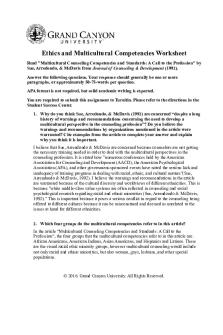Lactase worksheet PDF

| Title | Lactase worksheet |
|---|---|
| Author | Shainei |
| Course | Bio Core I: Molecular Systems |
| Institution | New York University |
| Pages | 2 |
| File Size | 179.8 KB |
| File Type | |
| Total Downloads | 15 |
| Total Views | 130 |
Summary
Got Lactase? The Co-evolution of Genes and Culture...
Description
Got Lactase? The Co-evolution of Genes and Culture
HANDOUT
INTRODUCTION You may know someone who is lactose intolerant—but do you really know what that means? This worksheet will test your knowledge by having you evaluate several statements about lactose intolerance. PROCEDURE After watching the film Got Lactase? The Co-evolution of Genes and Culture., read the statements below and decide whether the statement is true or false. Write one or two sentences to explain your answer to each statement. Include any evidence from the film that supports your answer. STATEMENTS 1. Baby mammals depend on milk to survive. - True. It supplies baby mammas with proteins, fats, and carbohydrates necessary for growth and survival.
2. Milk is a healthy food for an adult cat. - False. Most cats are lactose intolerant.
3. Throughout human history, people have always consumed the milk of other animals. - True. They didnt start consuming milk until 3500 BC in America. 4. Lactose is a sugar in milk. - True. It is a sugar that can be broken down into simple sugars like galactose and glucose 5. Most human adults around the world can digest the lactose in milk; a minority of people cannot digest lactose. - True. Only 1/3 of people have the mutations allowing them to digest the lactose in milk; a minority of people cannot digest lactose. 6. Digesting lactose causes a person’s blood glucose levels to increase. - True. Since lactose gets degraded into galactose and glucose, the glucose level will rise
7. Lactose intolerance is an allergy to milk and milk products. - True. It is a genetic trait and not an allergy since the genetic code determines who is lactose intolerant
8. Lactose intolerance is a genetic trait. - False. It is a genetic trait on chromosome 2 where the T was switched with a C, resulting in the ability to digest lactose.
www.BioInteractive.or
Updated March 2015
Got Lactase? The Co-evolution of Genes and Culture ANSWER QUESTIONS 9. What is Lactase? What reaction does it catalyze? Lactase is an enzyme produces by people who tolerate dairy products, which breaks down lactose in the body. Lactase catalyzes the hydrolysis of the glycosidic bond in the disaccharide lactose, releasing galactose and glucose.
10. When do mammals stop making lactase? What species can still produce lactase in adult? Most mammals stop producing lactase before 5-7 years old. Cattle can be accustom from their mothers’ milk
at 6 months to a year of age. 11. What is lactose intolerance? What is lactose persistence?
The inability to fully digest the sugars (lactose) in milk. However, humans that consume fresh milk and dairy products, lactase persistence allows adult subjects to digest lactose. 12. What test allows you to determine whether a person is lactose intolerance or not?
A doctor can tell whether you have lactose intolerance by asking questions about one’s symptoms. Sometimes doctors order a hydrogen breath test or a blood sugar test to confirm the diagnosis. 13. Do all human individuals, who are lactose persistence, have the same genetic mutation?
Most people in the world are lactose intolerant, but a genetic mutation where a cytosine nucleotide in a person's DNA is replaced with a thymine nucleotide allows them to digest milk. 14. What is the relationship between lactose persistence and their culture?
Lactase persistence is the continued activity of the lactase enzyme in adulthood. Since lactase’s only function is the digesting of lactose in milk, the activity of the enzyme is dramatically reduced after weaning. Cultural practices of dairying and milk drinking have spread in populations with a high prevalence of people with lactase persistence. 15. What drive the lactose persistence appear in human population?
The lactase persistence trait is more common in populations that practice cattle herding and dairy farming, and it is related to genetic selection of individuals with the ability to digest lactose
\
www.biointeractive.org
Page 2 of 2...
Similar Free PDFs

Lactase worksheet
- 2 Pages

Lactase Fact or Fiction Student
- 2 Pages

Worksheet
- 2 Pages

Worksheet#7(1) - worksheet
- 3 Pages

Ethics worksheet
- 4 Pages

Tissue Worksheet
- 3 Pages

Chromatography - Worksheet
- 3 Pages

Constitution Worksheet
- 3 Pages
Popular Institutions
- Tinajero National High School - Annex
- Politeknik Caltex Riau
- Yokohama City University
- SGT University
- University of Al-Qadisiyah
- Divine Word College of Vigan
- Techniek College Rotterdam
- Universidade de Santiago
- Universiti Teknologi MARA Cawangan Johor Kampus Pasir Gudang
- Poltekkes Kemenkes Yogyakarta
- Baguio City National High School
- Colegio san marcos
- preparatoria uno
- Centro de Bachillerato Tecnológico Industrial y de Servicios No. 107
- Dalian Maritime University
- Quang Trung Secondary School
- Colegio Tecnológico en Informática
- Corporación Regional de Educación Superior
- Grupo CEDVA
- Dar Al Uloom University
- Centro de Estudios Preuniversitarios de la Universidad Nacional de Ingeniería
- 上智大学
- Aakash International School, Nuna Majara
- San Felipe Neri Catholic School
- Kang Chiao International School - New Taipei City
- Misamis Occidental National High School
- Institución Educativa Escuela Normal Juan Ladrilleros
- Kolehiyo ng Pantukan
- Batanes State College
- Instituto Continental
- Sekolah Menengah Kejuruan Kesehatan Kaltara (Tarakan)
- Colegio de La Inmaculada Concepcion - Cebu







